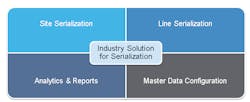Serialization for Life Sciences
The proliferation of counterfeit drugs is a big challenge for pharmaceutical companies as they struggle to protect the safety of their customers, the integrity of their brand, and, of course their sales. While counterfeit drugs slipping into the supply chain is not new, the illicit practice has become more prevalent due to Internet sales and global markets that make it easy for fake product to find its way into distribution. These conditions also make it difficult for manufacturers to find the point of entry.
For these reasons, the U.S. Food and Drug Administration (FDA) introduced the Drug Supply Chain Security Act (DSCSA), signed into law in 2013. The Act outlines the critical steps required to build an electronic, interoperable system that will be able to identify and trace prescription drugs distributed in the United States. Manufacturers, distributers, repackagers and dispensers will be required to phase in technology, procedures and best practices over the next several years in order to meet the stricter guidelines.
That path to DSCSA compliance starts with serialization—the assignment of unique, traceable numbers to individual items or saleable units. Serialization, based on GS1 standards for barcodes and electronic product codes (EPC), enables a drug to be tracked and traced electronically as it passes through the supply chain. This means, at any point, government authorities and pharmaceutical companies can not only identify and stop the distribution of counterfeit drugs, but also track phony drugs back to the source, as well as handle product recalls more effectively.
Many manufacturers have started the serialization journey, but they have not been able to meet the track and trace requirements to follow movement of the item across the supply chain. This is due to the lack of a holistic approach to serialization in the industry. Organizations have been doing “print and apply” for years. But the current serialization products come from packaging equipment providers or vision inspection suppliers with limited understanding of enterprise software and analytics.
Understanding the obstacles pharmaceutical companies face, Schneider Electric created their Industry Solutions group, to develop solutions addressing gaps in current industry offerings. This month, the company rolled out its Life Sciences Serialization Suite. The turnkey software suite includes Line Serialization, Site Serialization, Master Data Configuration, as well as Analytics and Reports.
Included in the offering is Schneider Electric’s Customer FIRST Software Maintenance and Support Program. This program gives access to the latest software upgrades, expert technical assistance and self-help tools, rounding out the turn-key approach to Schneider Electric’s solution delivery model.
The Line Serialization software, designed for the packaging line, focuses on the individual products going into boxes then to cartons and to containers and ultimately pallets. A unique identification number and barcode is associated with each of these stages in the packaging line, providing traceability for each step.
Out-of-the-box mandate templates provide aggregation (the process of building relationships between serial numbers) at each point in the packaging hierarchy, as well as serialization at a specific level, and the flexibility to switch between the global trade item number (GTIN) and the serial shipping contain code (SSCC).
The Site Serialization software can be integrated with manufacturing execution systems (MES) for broader visibility across the plant, as well as an on-premise database that stores all of the product and serial numbers—which helps in the event of a recall or quarantine. In addition, the system provides serialization/OEE comparative analysis and serial number reports for stock overviews, usage analysis, wastage analysis and SKU serialization management.
The biggest value-add of the Life Sciences Serialization Suite is the integrated design, said Maryanne Steidinger, director of industry solutions marketing for Schneider Electric Software. It has been purposely built to solve serialization across multiple packaging and organizational layers.
“There are a few different modules, but the distinction is that it is turnkey, so when a life sciences company buys this, it has all of the software and interfaces available to quickly install and configure,” said Steidinger. “There are no other offerings like this on the market now.”
It is also designed for collaboration. “We included a model-driven workflow as part of the solution which allows us to provide a standardized method of implementing the system and a standard way to communicate between all stakeholders,” she said.
Here’s how it works: When an order is received from an Enterprise Resource Planning (ERP) system, the Site Serialization module creates a packaging order, configures the master data, requests, receives and stores the serial numbers from Electronic Product Code Information Services (EPCIS), and dispatches orders to specific lines. The Line Serialization receives the order, starts and completes printing, then uploads the serial number statistics and aggregation data to Site Serialization, which sends commissioning information to EPCIS and generates analytics reports as well as archives the data.
Information is exchanged through database views based on the order status leveraging Wonderware Skelta business process management (BPM) technology and Site DB MS SQL Server.
Due to its native integration with MES, the Schneider Electric Life Sciences Serialization Suite enables end-to-end track and trace from manufacturing through the supply chain. And by adding integrated analytics and real-time visibility, it is safe to say that this is the serialization solution life science companies have been seeking.

